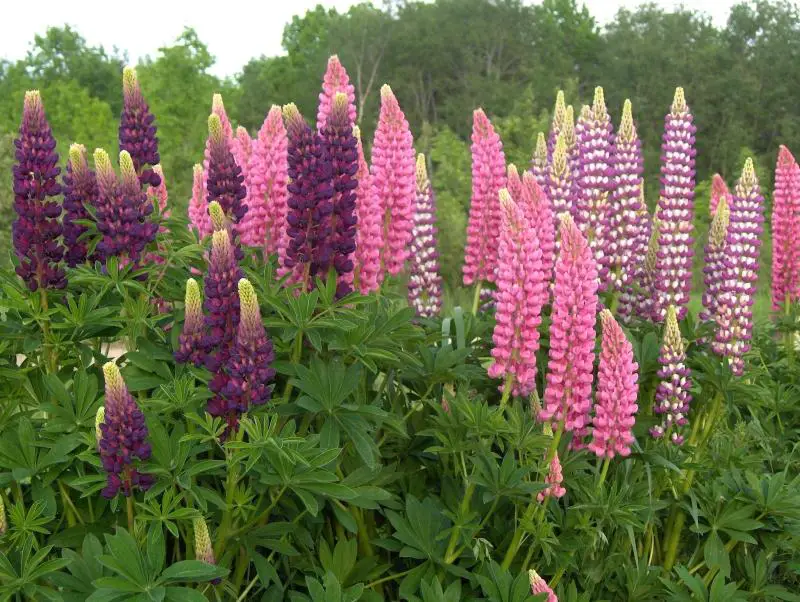Lupines are admired for their tall, vibrant flower spikes and lush foliage. These plants bring bold vertical interest and rich color to gardens. Knowing when lupines bloom helps gardeners plan their landscapes to ensure continuous garden beauty. Blooming times can vary based on species and growing conditions. This article explores the blooming calendar, environmental factors, and practical care tips. Following these guidelines will help you enjoy lupines’ stunning flowers to their fullest.
Lupines thrive in temperate climates and adapt well to different garden settings. Whether you grow annual or perennial lupines, understanding their flowering patterns improves your garden’s visual appeal. With proper care, you can encourage longer bloom periods and healthier plants. This comprehensive guide covers everything from planting timing to pruning techniques, ensuring your lupines shine season after season.
Understanding Lupine Bloom Cycles

What Influences Lupine Blooming Time?
Lupine flowering depends on multiple factors such as species, climate, soil quality, and planting date. Most lupines begin blooming in late spring and continue through early summer. In cooler climates, blooms may appear later due to slower growth rates. Conversely, warmer areas often see earlier flowering as plants respond to rising temperatures.
Day length plays a crucial role in triggering lupine blooms. Longer daylight hours signal the plant to enter its flowering phase. Temperature fluctuations also impact timing; sudden cold snaps can delay blooms. Soil conditions like drainage and fertility influence growth vigor, which in turn affects flowering strength and timing. Stress from drought or nutrient deficiency can shorten bloom duration or reduce flower size.
Bloom Duration and Variations Among Lupine Species
Different lupine species offer varying bloom lengths and styles. Russell hybrid lupines, popular in gardens, typically flower for six to eight weeks under ideal conditions. Perennial lupines such as Lupinus polyphyllus may have a similar bloom span and sometimes rebloom if cared for properly. Annual species like Lupinus nanus usually produce a shorter, more intense flowering display concentrated in a few weeks.
Colors range widely from deep purples and blues to pinks, whites, and yellows. Selecting multiple species and cultivars with staggered bloom times can create continuous color in your garden. Additionally, variations in height and flower density enhance visual texture and interest. Proper care extends bloom longevity across these diverse lupine types.
Typical Bloom Time for Lupines by Region
Bloom Time in Cool Temperate Climates
In cooler regions such as northern states or high-altitude areas, lupines bloom primarily from June through July. The chillier temperatures slow plant development, pushing back flowering dates. Gardeners should sow seeds early in spring to allow adequate time for growth before blooming begins.
Lupines perform well in these cooler zones, especially when soil moisture is consistent. Mulching helps regulate soil temperature and retain moisture, protecting roots from temperature swings. Proper spacing encourages airflow, reducing disease risk and supporting healthy blooms. Winter protection or mulching may be needed for perennials to ensure spring resurgence.
Bloom Time in Mild to Warm Climates
In warmer climates, lupines can start blooming as early as April or May. Early spring planting enables plants to capitalize on cooler temperatures before summer heat. However, hot, dry summers often shorten bloom periods, causing flowers to fade quickly.
Gardeners in warm zones benefit from afternoon shade or planting lupines near taller plants to reduce heat stress. Frequent watering during bloom enhances flower size and duration. Avoid over-fertilizing, which leads to lush leaves but fewer flowers. Selecting heat-tolerant lupine varieties further improves bloom success in these regions.
Preparing Your Garden for Lupine Bloom
Choosing the Best Planting Time
Planting lupines at the right time is critical for healthy blooms. Early spring sowing is ideal in most areas. This gives seeds enough time to germinate, grow roots, and develop before flowering. In frost-prone zones, delay planting until danger of frost has passed to avoid damage.
In mild climates, fall planting is effective as natural cold stratification breaks seed dormancy. This method encourages stronger germination in spring. Transplants can also be started indoors several weeks before the last frost date. Timing your planting ensures lupines have ample growing time, resulting in robust blooms.
Soil Preparation and Fertilization for Bloom Success
Lupines thrive in loose, well-draining soil. Heavy or compacted soils delay root growth and reduce flowering. Before planting, loosen soil to at least 12 inches deep. Incorporate organic matter such as compost to improve texture and fertility.
Lupines prefer slightly acidic to neutral pH (6.0 to 7.0). Conduct a soil test to determine pH and nutrient levels. Avoid high nitrogen fertilizers since lupines fix nitrogen via root nodules. Excess nitrogen causes more leafy growth but fewer flowers. Instead, use balanced or phosphorus-rich fertilizers to support flower development.
How to Extend the Blooming Period of Lupines
Watering Practices to Encourage Longer Blooms
Consistent watering supports vibrant lupine blooms. Water lupines deeply once or twice weekly, depending on rainfall and temperature. Keeping soil evenly moist but not soggy prevents stress that can shorten flower life. Avoid overhead watering to reduce fungal disease risks.
Mulching around plants helps retain moisture and regulate temperature. Use organic mulch such as shredded bark or straw. This also limits weed growth which competes for water. During heat waves or droughts, increase watering frequency carefully. Proper hydration encourages larger, longer-lasting flower spikes and prevents premature wilting.
Fertilizing for Prolonged Flowering
Fertilizing lupines at key stages boosts flower production. Apply a low-nitrogen, high-phosphorus fertilizer when buds form to promote blooms. Too much nitrogen causes lush foliage but fewer flowers.
Use slow-release fertilizers to provide steady nutrients over time. Avoid overfeeding, which may cause excessive leaf growth or weak stems. Regular feeding supports healthy, sustained flowering throughout the bloom period. Timing fertilizer applications with watering maximizes uptake.
Deadheading and Pruning to Stimulate New Blooms
Removing spent flowers encourages lupines to produce additional blooms. Deadheading prevents seed formation, which diverts energy from flowering. Pinch or cut flower spikes once they fade, leaving some leaves intact.
Light pruning after bloom ends can rejuvenate plants. Cut back flower stems to the base to stimulate fresh growth. Avoid cutting too harshly during the blooming period. Pruning encourages branching, leading to bushier plants and more flowers next season.
Environmental Factors Affecting Lupine Bloom
The Role of Temperature and Sunlight
Lupines bloom best with full sun and cool to moderate temperatures. Ideal daytime temperatures range between 60°F and 75°F (15°C to 24°C). Excessive heat shortens flowering and causes blooms to fade quickly.
Shorter days or cloudy weather delay bloom onset. Providing at least 6 hours of direct sunlight daily is essential for strong flower development. In hot climates, some afternoon shade protects lupines from heat stress. Morning sun with afternoon shade extends bloom duration.
Impact of Soil Conditions on Flowering
Well-drained soil is critical for lupine health and bloom quality. Waterlogged or compacted soil suffocates roots, leading to poor flowering. Adding organic matter improves drainage and nutrient availability.
Sandy or loamy soils promote healthy root growth. Avoid soils that are too rich in nitrogen, as this favors leaves over flowers. Slightly acidic to neutral pH supports nutrient uptake necessary for vibrant blooms.
Pests and Diseases That Can Limit Blooming
Common pests like aphids and slugs damage lupine buds and flowers. Aphids suck plant sap, weakening growth and causing flower drop. Slugs chew on leaves and buds, directly reducing bloom numbers.
Fungal diseases such as powdery mildew or root rot interfere with flowering. Maintaining proper spacing and watering at soil level minimizes disease. Early detection and organic controls preserve flower health and prolong bloom time.
Tips for Maximizing Lupine Color in Your Garden
Selecting Lupine Varieties for Extended Color
Choosing a variety of lupine species and cultivars ensures your garden stays colorful for weeks. Russell hybrids are popular for their long bloom time and vibrant blues, purples, and pinks. Perennial lupines may produce a second, lighter bloom in late summer, extending visual interest.
Mixing lupines of different heights and colors adds depth and texture to your garden design. Taller lupines create vertical focal points, while shorter ones fill spaces along borders and edges. Staggered bloom times prevent gaps in flower displays, keeping your garden lively and full of color.
By planting a diverse lupine selection, you maximize bloom duration and create dynamic, layered floral scenes. This variety helps maintain garden appeal from spring into early fall.
Using Companion Plants to Enhance Lupine Displays
Pairing lupines with complementary perennials creates a balanced and rich garden palette. Plants like delphiniums, foxgloves, and peonies offer softer shapes and round blooms that contrast well with lupines’ tall spikes. This blend adds variety and visual harmony.
Companion plants also protect lupines from harsh sun and wind in exposed areas. Choose species that share similar water needs to prevent competition and stress. Drought-tolerant companions work well in dry gardens, while moisture-loving plants thrive in cooler, wetter spots.
Using the right companions extends bloom periods and enriches color saturation throughout the garden. This strategy creates a thriving, resilient planting environment that supports lupine growth and beauty.
Garden Design Strategies for Impactful Lupine Displays
Plant lupines in clusters or sweeping drifts to mimic natural meadows. Grouping creates bold color bursts that catch the eye and make a strong statement. This naturalistic style works well along borders, pathways, and cottage gardens.
Repeat lupine colors across the garden for a cohesive and harmonious look. Combine lupines with flowering bulbs and ornamental grasses to maintain interest throughout different seasons. Planning bloom timing with early spring bulbs and summer perennials creates continuous color flow.
Layering plants by height and bloom period adds dimension and structure. Thoughtful placement enhances garden rhythm and invites visitors to explore the space.
Caring for Lupines During and After Bloom
Post-Bloom Care to Encourage Next Season’s Flowers
After lupines finish blooming, it’s important to cut back spent flower spikes promptly. This practice directs the plant’s energy into producing new growth instead of seed development. Remove any dead, yellowing, or diseased leaves to improve air circulation and reduce pest or disease risks. Applying a balanced fertilizer with moderate phosphorus and potassium supports healthy root development and robust foliage. During this recovery phase, maintain consistent watering to help plants rebuild their energy reserves. For perennial lupines, applying a layer of organic mulch around the base after blooming insulates the roots, conserves moisture, and protects the plant during colder months. Proper post-bloom care ensures lupines are well-prepared for vigorous growth and abundant flowering in the following season.
Preparing Lupines for Winter Dormancy
In colder climates, protecting perennial lupines through winter is essential for their survival and future blooming potential. Apply a thick layer of mulch, such as straw, shredded leaves, or bark chips, around the root zone to insulate against freezing temperatures. Gradually reduce watering as plants enter dormancy to avoid root rot from excess moisture. It is best to stop fertilizing by late summer or early fall to prevent the growth of tender shoots that may not survive frost. In mild or Mediterranean climates, lupines may remain semi-evergreen; in these areas, continue light watering but avoid overwatering. Remove any dead or damaged foliage during winter to maintain plant health. Thoughtful winter care enhances the strength of spring blooms and extends lupine longevity.
Troubleshooting Common Lupine Blooming Problems
Insufficient Sunlight
Lupines require at least six hours of direct sunlight daily to bloom well. If your plants are in shaded or partially shaded areas, they may produce fewer flowers or none at all. Consider relocating your lupines to a sunnier spot or trimming nearby plants that block light. Lack of adequate sunlight weakens the plant’s energy reserves, limiting flower development.
Over-Fertilization with Nitrogen
Too much nitrogen fertilizer promotes leafy, lush growth but suppresses flower production. Use a balanced fertilizer with low nitrogen content or one formulated specifically for flowering plants. Applying fertilizer in early spring supports healthy growth, but avoid excessive feeding during the growing season to encourage more blooms.
Poor Soil Drainage
Lupines prefer well-drained soil. Waterlogged or compacted soil can cause root stress, reducing flowering. Ensure your soil drains quickly by amending it with organic matter like compost or coarse sand. Raised beds or containers with drainage holes also help prevent water accumulation around the roots.
Improper Watering Practices
Both overwatering and underwatering can hinder lupine blooming. Consistently moist but not soggy soil is ideal. Overwatering leads to root rot, while underwatering causes drought stress. Water deeply but less frequently, allowing the soil to dry slightly between watering sessions. Mulching helps maintain even soil moisture.
Pest and Disease Issues
Aphids, slugs, and fungal diseases like powdery mildew can weaken lupines, affecting their ability to bloom. Regularly inspect plants and treat infestations early with organic pesticides or natural remedies. Maintain good airflow and avoid overhead watering to reduce fungal problems.
Incorrect Plant Spacing
Crowded lupines compete for light, nutrients, and water, leading to fewer blooms. Thin seedlings or space plants adequately when planting, typically 6 to 12 inches apart. Proper spacing improves air circulation and reduces disease risk, supporting healthier, more vigorous flowering.
Environmental Stress and Weather Conditions
Extreme heat, drought, or unexpected frosts can stress lupines and delay or reduce flowering. Protect young plants with shade cloth during heatwaves and mulch to regulate soil temperature. In cold climates, plant lupines after the last frost or provide frost protection to prevent damage.
FAQ: When Does Lupine Bloom? Tips to Maximize Your Garden’s Color
How long does the lupine blooming period typically last?
Lupines generally bloom for about 4 to 6 weeks during late spring to early summer. Bloom length depends on climate, care, and variety. Cooler temperatures and regular watering help prolong blooms. Removing spent flowers through deadheading encourages the plant to produce more flowers, extending the vibrant display.
What is the best time of year to plant lupine seeds for optimal blooming?
The best time to plant lupine seeds depends on your climate. In colder regions, sow seeds in fall to benefit from natural cold stratification, improving germination. In warmer areas, early spring sowing allows seedlings to grow during cooler months, promoting strong roots and earlier blooming. Proper seed preparation, such as scarification, also boosts success.
How can I encourage lupines to bloom more abundantly?
To encourage more blooms, plant lupines in full sun with well-drained soil. Avoid excessive nitrogen fertilizers to prevent leafy growth at the expense of flowers. Keep soil consistently moist but not waterlogged. Deadhead spent flowers regularly to redirect energy into producing new blooms. Providing adequate spacing improves airflow, reducing disease risk and promoting healthy flowering.
Why are my lupines not producing flowers despite healthy foliage?
Lupines may fail to flower due to over-fertilizing with nitrogen, which favors foliage growth. Insufficient sunlight or poor drainage can also inhibit blooming. Environmental stress such as drought or extreme heat can delay flowers. Adjust fertilizer use, ensure at least six hours of sunlight daily, and improve soil drainage to encourage flowering.
Can I extend the lupine blooming season in my garden?
You can extend the blooming season by planting multiple lupine varieties with different bloom times. Regular deadheading removes spent flowers, promoting continuous blooming. Maintain consistent watering and protect plants from harsh weather. Mulching helps retain soil moisture and regulate temperature, supporting longer-lasting flowers in your garden.
Conclusion
Understanding when lupines bloom helps gardeners plan for spectacular color displays. Bloom times vary with species, climate, and care. By providing proper soil, watering, and fertilizing, you encourage healthy, long-lasting flowers. Choosing a variety of lupines with staggered bloom periods extends garden interest. Companion planting and thoughtful garden design enhance lupines’ natural beauty. Post-bloom care and troubleshooting common issues ensure vibrant blooms year after year. With attention to these tips, your garden will thrive with stunning lupine flowers that captivate throughout the growing season.






